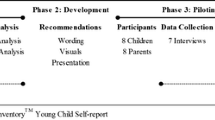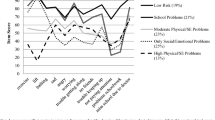Abstract
We examined the subjective health and well-being of 389 transition-age youth with autism or intellectual disability using the parent proxy version of the KIDSCREEN-27. Parents reported well-being of youth with autism and youth with intellectual disability lower than a normative sample in the domains of Physical Well-being, Psychological Well-being, and Social Support and Peers. For both groups of young people, the lowest ratings were reported in Social Support and Peers. Higher ratings of well-being in one or more domains were predicted by minority status, youth character strengths, involvement in community activities, and religious faith. Challenging behaviors, autism, age, and speech as the primary mode of communication were predictive of lower ratings of well-being. We discuss implications for special educators and service providers and offer directions for future research.
Similar content being viewed by others
References
Carter, E. W., Boehm, T. L., Annandale, N. H., & Taylor, C. (in press). Supporting congregational inclusion for children and youth with intellectual disability or autism and their families. Exceptional Children.
Carter, E. W., Boehm, T. L., Biggs, E. E., Annandale, N. H., Taylor, C. E., Loock, A. K., & Liu, R. Y. (2015). Known for my strengths: Positive traits of transition-age youth with intellectual disability and/or autism. Research and Practice for Persons with Severe Disabilities, 40, 101–119. doi:10.1177/1540796915592158.
Carter, E. W., Brock, M. E., & Trainor, A. A. (2014). Transition assessment and planning for youth with severe intellectual and developmental disabilities. The Journal of Special Education, 47, 245–255. doi:10.1177/0022466912456241.
Carter, E. W., Ditchman, N., Sun, Y., Trainor, A. A., Swedeen, B., & Owens, L. (2010). Summer employment and community experiences of transition-age youth with severe disabilities. Exceptional Children, 76, 194–212. doi:10.1177/001440291007600204.
Carter, E. W., & Hughes, C. (2013). Teaching social skills and promoting supportive relationships. In P. Wehman (Ed.), Life beyond the classroom (5th ed., pp. 249–268). Baltimore, MD: Paul H. Brookes.
Carter, E. W., Lane, K. L., Cooney, M., Weir, K., Moss, C. K., & Machalicek, W. (2013). Parent assessments of self-determination importance and performance for students with autism or intellectual disability. American Journal on Intellectual and Developmental Disabilities, 88, 16–31. doi:10.1352/1944-7558-118.1.16.
Clark, B. G., Magill-Evans, J. E., & Koning, C. J. (2015). Youth with autism spectrum disorders: Self- and proxy-reported quality of life and adaptive functioning. Focus on Autism and Other Developmental Disabilities, 30, 57–64. doi:10.1177/1088357614522289.
Cohen, J. (1988). Statistical power analysis for the behavioral sciences (2nd ed.). Mahwah, NJ: Erlbaum.
Davis, E., Nicholas, C., Waters, E., Cook, K., Gibbs, L., Gosch, A., & Ravens-Sieberer, U. (2007). Parent-proxy and child self-reported health-related quality of life: Using qualitative methods to explain the discordance. Quality of Life Research, 16, 863–871. doi:10.1007/s11136-007-9187-3.
Dey, M., Landolt, M. A., & Mohler-Kuo, M. (2013). Assessing parent-child agreement in health-related quality of life among three health status groups. Social Psychiatry and Psychiatric Epidemiology, 48, 503–511. doi:10.1007/s00127-012-0556-z.
Felce, D., & Perry, J. (2007). Living with support in the community. In S. L. Odom, R. H. Horner, M. E. Snell, & J. Blacher (Eds.), Handbook of developmental disabilities (pp. 410–428). New York, NY: Guilford Press.
Foley, K. R., Dyke, P., Girdler, S., Bourke, J., & Leonard, H. (2012). Young adults with intellectual disability transitioning from school to post-school: A literature review framed within the ICF. Disability and Rehabilitation, 34, 1747–1764. doi:10.3109/09638288.2012.660603.
Forte, M., Jahoda, A., & Dagnan, D. (2011). An anxious time? Exploring the nature of worries experienced by young people with a mild to moderate intellectual disability as they make the transition to adulthood. British Journal of Clinical Psychology, 50, 398–411. doi:10.1111/j.2044-8260.2010.02002.x.
Haber, M. G., Mazzotti, V. L., Mustian, A. L., Rowe, D. A., Bartholomew, A. L., & Fowler, C. H. (2015). What works, when, for whom, and with whom: A meta-analytic review of predictors of postsecondary success for students with disabilities. Review of Educational Research. doi:10.3102/0034654315583135.
Harrell, F. E. (2001). Regression modeling strategies: With applications to linear models, logistic regression, and survival analysis. New York, NY: Springer.
Hebron, J., & Humphrey, N. (2012). Mental health difficulties among young people on the autistic spectrum in mainstream secondary schools: A comparative study. Journal of Research in Special Educational Needs, 14, 22–32. doi:10.1111/j.1471-3802.2012.01246.x.
Hensel, E., Rose, J., Kroese, B. S., & Banks-Smith, J. (2002). Subjective judgements of quality of life: A comparison study between people with intellectual disability and those without disability. Journal of Intellectual Disability Research, 46, 95–107. doi:10.1046/j.1365-2788.2002.00343.x.
Individuals with Disabilities Education Improvement Act (IDEA). Final Regulations, 2006.
Kamp-Becker, I., Schröder, J., Muehlan, H., Remschidt, H., Becker, K., & Bachmann, C. J. (2011). Health-related quality of life in children and adolescents with autism spectrum disorder. Zietschrift fur Kinder Jugendpsychiatrei und Psychotherapie, 39(2), 13–31. doi:10.1024/1422-4917/a000098.
Kamp-Becker, I., Schröder, J., Remschmidt, H., & Bachmann, C. J. (2010). Health-related quality of life in adolescents and young adults with high functioning autism-spectrum disorder. GMS Psycho-Social Medicine. doi:10.3205/psm000065.
Kober, R. (Ed.). (2011). Enhancing the quality of life of people with intellectual disabilities: From theory to practice. New York, NY: Springer.
Koenig, H. G., King, D. E., & Carson, V. B. (2012). Handbook of religion and health (2nd ed.). New York, NY: Oxford University Press.
Kraemer, B. R., McIntyre, L. L., & Blacher, J. (2003). Quality of life for young adults with mental retardation during transition. Mental Retardation, 41, 250–262. doi:10.1352/00476765(2003)41<250:QOLFYA>2.0.CO;2.
Kuhlthau, K., Kovacs, E., Hall, T. A., Clemmons, T., Orlich, F., Delahaye, J., & Sikora, D. (2013). Health-related quality of life for children with ASD: Associations with behavioral characteristics. Research in Autism Spectrum Disorders, 7, 1035–1042. doi:10.1016/j.rasd.2013.04.006.
Kuhlthau, K., Orlich, F., Hall, T. A., Sikora, D., Kovacs, E. A., Delahaye, J., & Clemons, T. E. (2010). Health-related quality of life in children with autism spectrum disorders: Results from the autism treatment network. Journal of Autism and Developmental Disorders, 40, 721–729. doi:10.1007/s10803-009-0921-2.
Lau, K., Chow, S. M., & Kai Lo, S. (2006). Parents’ perception of the quality of life of preschool children at risk or having developmental disabilities. Quality of Life Research, 15, 1133–1141. doi:10.1007/s11136-006-0067-z.
Lee, S. H., Wehmeyer, M. L., Palmer, S. B., Soukup, J. H., & Little, T. D. (2008). Self-determination and access to the general education curriculum. The Journal of Special Education, 42, 91–107. doi:10.1177/0022466907312354.
Liu, E. X., Carter, E. W., Boehm, T. L., Annandale, N. H., & Taylor, C. E. (2014). In their own words: The place of faith in the lives of young people with autism and intellectual disability. Intellectual and Developmental Disabilities, 52, 388–404. doi:10.1352/1934-9556-52.5.388.
Mahoney, J. L., Harris, A. L., & Eccles, J. S. (2006). Organized activity participation, positive youth development, and the over-scheduling hypothesis. Social Policy Report, 20, 3–32.
Plante, T. G., & Boccaccini, M. (1997). The Santa Clara strength of religious faith questionnaire. Pastoral Psychology, 45, 375–387. doi:10.1007/BF02230993.
Proctor, C., Maltby, J., & Linley, P. A. (2011). Strengths use as a predictor of well-being and health related quality of life. Journal of Happiness Studies, 12, 153–169. doi:10.1007/s10902-009-9181-2.
Ratcliffe, B., Wong, M., Dossetor, D., & Hayes, S. (2015). The association between social skills and mental health in school-aged children with autism spectrum disorder, with and without intellectual disability. Journal of Autism and Developmental Disorders.
Ravens-Sieberer, U., Auquier, P., Erhart, M., Gosch, A., Rajmil, L., Bruil, J., & The European KIDSCREEN Group. (2007). The KIDSCREEN-27 quality of life measure for children and adolescents: psychometric results from a cross-cultural survey in 13 European countries. Quality of Life Research, 16, 1347–1356. doi:10.1007/s11136-007-9240-2.
Ravens-Sieberer, U., Gosch, A., Rajmil, L., Erhart, M., Bruil, J., & The European KIDSCREEN Group. (2005). KIDSCREEN-52 quality of life measure for children and adolescents. Expert Review of Pharmacoeconomics & Outcomes Research, 5, 353–364. doi:10.1586/14737167.5.3.353.
Renty, J., & Roeyers, H. (2006). Quality of life in high-functioning adults with autism spectrum disorder. Autism, 10, 511–524. doi:10.1177/1362361306066604.
Robitail, S., Ravens-Sieberer, U., Simeoni, M., Rajmil, L., Bruil, J., Power, M., & the KIDSCREEN Group. (2007). Testing the structural and cross-cultural validity of the KIDSCREEN-27 quality of life questionnaire. Quality of Life Research, 16, 1335–1345. doi:10.1007/s11136-007-9241-1.
Schalock, R. L. (2004). The concept of quality of life: What we know and do not know. Journal of Intellectual Disability Research, 48, 203–216. doi:10.1111/j.1365-2788.2003.00558.x.
Schalock, R. L., & Keith, K. D. (1993). Quality of life questionnaire. Columbus, OH: IDS.
Shattuck, P. T., Orsmond, G. I., Wagner, M., & Cooper, B. P. (2011). Participation in social activities among adolescents with an autism spectrum disorder. PLoS One, 6, e27176. doi:10.1371/journal.pone.0027176.
Shipman, D., Sheldrick, S., & Perrin, E. C. (2011). Quality of life of adolescents with autism spectrum disorders: Reliability and validity of self-reports. Journal of Developmental and Behavioral Pediatrics, 32, 85–89. doi:10.1097/DBP.0b013e318203e558.
Shogren, K. A., Lopez, S. H., Wehmeyer, M. L., Little, T. D., & Pressgrove, C. L. (2006). The role of positive psychology constructs in predicting life satisfaction in adolescents with and without cognitive disabilities, an exploratory study. The Journal of Positive Psychology, 1, 37–52. doi:10.1080/17439760500373174.
Tavernor, L., Barron, E., Rodgers, J., & McConachie, H. (2013). Finding out what matters: Validity of quality of life measurement in young people with ASD. Child: Care, Health, and Development, 39, 592–601. doi:10.1111/j.1365-2214.2012.01377.x.
Taylor, R. M., Gibson, F., & Franck, L. S. (2008). A concept analysis of health-related quality of life in young people with chronic illness. Journal of Clinical Nursing, 17, 1823–1833. doi:10.1111/j.13.65-2702.2008.02379.x.
Test, D. W., Smith, L., & Carter, E. W. (2014). Equipping youth with autism spectrum disorders for adulthood: Promoting rigor, relevance, and relationships. Remedial and Special Education, 35, 80–90. doi:10.1177/0741932513514857.
The KIDSCREEN Group Europe. (2006). The KIDSCREEN Questionnaires: Quality of life questionnaires for children and adolescents. Lengerich: Pabst Science Publishers.
Tilford, J. M., Payakachat, N., Kovacs, E., Pyne, J. M., Brouwer, W., Nick, T. G., & Kuhlthau, K. A. (2012). Preference-based health-related quality-of-life outcomes in children with autism spectrum disorders: A comparison of generic instruments. Pharmacoeconomics, 30, 661–679. doi:10.2165/11597200-000000000-00000.
Turnbull, H. R., Turnbull, A. P., Wehmeyer, M. L., & Park, J. (2003). A quality of life framework for special education outcomes. Remedial and Special Education, 24, 67–74. doi:10.1177/07419325030240020201.
Umberson, D., & Montez, J. K. (2010). Social relationships and health: A flashpoint for health policy. Journal of Health and Social Behavior, 51, S54–S66. doi:10.1177/0022146510383501.
Wagner, M., Cadwallader, T., & Marder, C. (2003). Life outside the classroom for youth with disabilities. Menlo Park, CA: SRI International.
Wehmeyer, M. L., & Abery, B. H. (2013). Self-determination and choice. Intellectual and Developmental Disabilities, 51, 399–411. doi:10.1352/1934-9556-51.5.399.
Wei, X., Wagner, M., Hudson, L., Yu, J. W., & Shattuck, P. (2015). Transition to adulthood: Employment, education, and disengagement in individuals with autism spectrum disorders. Emerging Adulthood, 3, 37–45. doi:10.1177/2167696814534417.
Wolman, J. M., Campeau, P. L., DuBois, P. A., Mithaug, D. E., & Stolarski, V. S. (1994). AIR self-determination scale and user guide. Palo Alto, CA: American Institute for Research.
Woodard, C. (2009). Psychometric properties of the ASPeCT-DD: Measuring positive traits in persons with developmental disabilities. Journal of Applied Research in Intellectual Disabilities, 22, 433–444. doi:10.1111/j.1468-3148.2009.00494.x.
Acknowledgments
The work reported in this article was supported by funding from the Martin McCoy-Jesperson Discovery Grants in Positive Psychology. We appreciate the contributions of Naomi Annandale, Thomas Boehm, Eleanor Liu, and Courtney Taylor to this project.
Author information
Authors and Affiliations
Corresponding author
Rights and permissions
About this article
Cite this article
Biggs, E.E., Carter, E.W. Quality of Life for Transition-Age Youth with Autism or Intellectual Disability. J Autism Dev Disord 46, 190–204 (2016). https://doi.org/10.1007/s10803-015-2563-x
Published:
Issue Date:
DOI: https://doi.org/10.1007/s10803-015-2563-x




